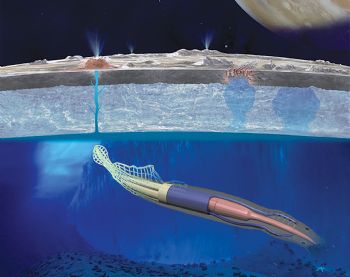
A team from Cornell University in New York state has designed a robotic eel — Robo-eel — that can propel and power itself. NASA has awarded the idea a Phase One spot on its Innovative Advanced Concepts programme; it has also supplied $100,000 to develop the technology.
The robot is designed specifically to explore giant moons like Jupiter’s icy satellite Europa. It is believed that vast oceans lie under the cold crust of that moon (in 2013 the Hubble telescope captured what looked like 200km-high jets of water bursting from Europa’s surface) — and maybe even life.
Among the problems with getting a closer look at this intriguing world is power; Jupiter receives 25% less sunlight than Earth, putting traditional solar-panel designs at a severe disadvantage.
However, NASA decided to cancel its Advanced Stirling Radioisotope Generator (ASRG) project in 2013; this would have delivered plutonium-based power systems for missions to sunlight-poor environments — including polar regions and liquid landscapes, like the lake on Saturn’s moon, Titan.
Robo-eel is designed to get around this issue by using magnetic fields — and not the sun — as its power source. The underwater rover would use its tentacle-like appendages as ‘electrodynamic tethers’ to capture energy from shifting magnetic fields on Europa.
Mason Peck, associate professor of mechanical and aerospace engineering at Cornell, said: “The bio-inspired technologies that we propose bypass the need to power rovers with limited-lifetime batteries, large solar arrays or nuclear power. Beyond addressing issues of power, this rover concept also bypasses the difficulties of typical mechanisms in fluids through uniquely suited soft robotics.”
The energy that the robot harnesses will also be used to conduct electrolysis on surrounding water to produce hydrogen and oxygen, which are stored and intermittently ignited to expand various chambers and propel itself through the water.
Mr Peck adds: “Optionally, the skin of the robot will be a stretchable, electro-luminescent display for illuminating the local marine environment to enable underwater imaging. This bio-inspired technology represents a tremendous leap forward in what we understand a rover to be.”